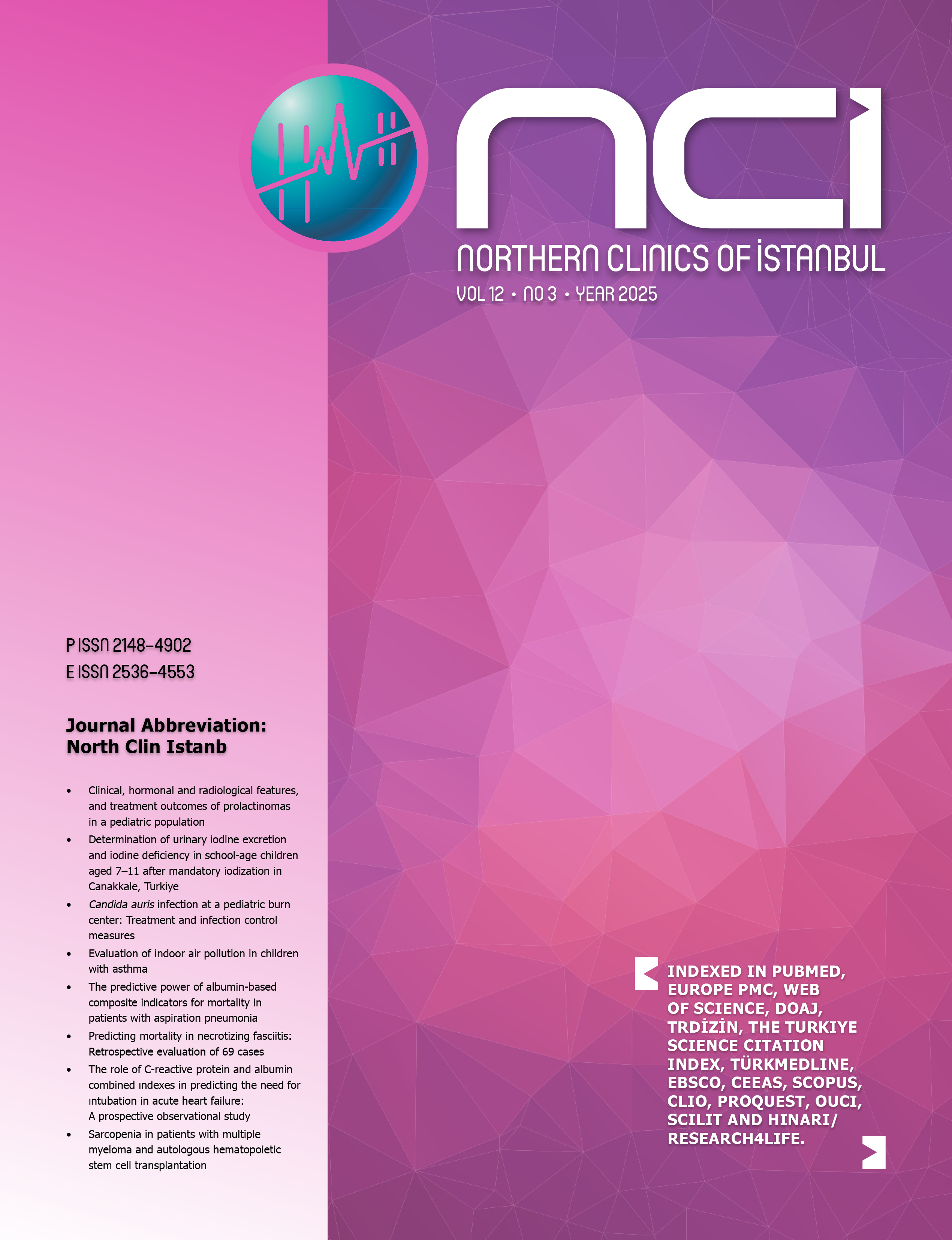Volume: 7 Issue: 1 - 2020
| RESEARCH ARTICLE | |
| 1. | Examination of the expression levels of MACC1, Filamin A and FBXW7 genes in colorectal cancer patients Funda Yeşilkaya, Didem Tastekin, Hani Al Saadoni, Arzu Ergen, Sadrettin Pence PMID: 32232196 PMCID: PMC7103745 doi: 10.14744/nci.2019.26780 Pages 1 - 5 OBJECTIVE: Colorectal cancer (CRC) is the third most common type of cancer observed in cancer-related mortality because it has a high metastasis ratio. This study aims to investigate the expression levels of several genes, including metastasis-related colon cancer 1 (MACC1), Filamin A (FLNA), F-box/WD repeat-containing protein 7 (FBXW7), which has an important role in cell signaling, migration and adhesion through the remodeling of the cell skeleton. METHODS: In this study, 21 patients with a precise diagnosis of CRC and 21 controls were included. Gene expressions were examined using the RT-PCR technique. To define the relationship of the genes with metastasis, blood samples were collected from all patients with colon/rectal cancer diagnosis without metastasis at six months before and after the medication with Xelox. RESULTS: Our findings showed that no significant difference was observed in the pre-treatment values compared to the control group, whereas FLNA (p=0.001) expression was observed to be significantly increased following treatment with Xelox. CONCLUSION: To our knowledge, our study is the first study to investigate the effects of Xelox treatment on the expression levels of MACC1, FBXW7 and FLNA genes in non-metastatic colorectal cancer patients in Turkey. |
| 2. | Detection of human immunodeficiency virus (HIV) RNA in the sweat of HIV-infected patients Fatih Mehmet Hanege, Fatma Sargin, Servet Karaca, Oguz K. Egilmez, Haluk Vahaboglu, M. Tayyar Kalcioglu PMID: 32232197 PMCID: PMC7103743 doi: 10.14744/nci.2019.56255 Pages 6 - 10 OBJECTIVE: Human immunodeficiency virus (HIV) infection is a significant health problem. Many studies reported that HIV was mainly transmitted through parenteral exposure, sexual activity, and body secretions, such as saliva and semen. Many people, including health-care providers and patient relatives, may easily contact with the sweat of HIV-infected patients. Although reference books assert that HIV does not transmit through sweat, to our knowledge, there is no systemic study which this statement is based upon. This study aims to investigate the potential of sweat to transmit HIV infection. METHODS: This study included 31 treatment-naive HIV RNA-positive patients who were in the acute phase of the infection and 26 subjects with a negative HIV RNA test who had received antiviral treatment. A total of 57 sweat samples collected from intact skin areas were prospectively evaluated by polymerase chain reaction (PCR) for the presence of HIV RNA. HIV RNA levels in the blood samples were also noted. RESULTS: HIV RNA was not detected by PCR in any sweat sample taken from HIV-infected HIV RNA-negative and -positive subjects. CONCLUSION: The findings obtained in this study suggest that sweat by itself has no potential for transmitting HIV infection. |
| 3. | Lateral oblique approach for internal jugular vein catheterization: Randomized comparison of oblique and short-axis view of ultrasound-guided technique Onur Balaban, Tayfun Aydın, Ahmet Musmul PMID: 32232198 PMCID: PMC7103737 doi: 10.14744/nci.2019.86658 Pages 11 - 17 OBJECTIVE: The lateral oblique approach is a novel needle-in-plane technique for ultrasound-guided catheterization of the internal jugular vein. In this study, we aimed to compare the oblique approach with the classical short-axis technique for facilitating the procedure and reduction of mechanical complications. METHODS: This research was planned as a prospective study. Eighty-four open-heart surgery patients requiring a central venous catheter were randomly allocated into two groups: Oblique approach group (n=42) and short-axis group (n=42). Time to cannulate, the number of necessary puncture attempts, and frequency of carotid artery puncture, hematoma, puncture site bleeding, pneumothorax, and hemothorax in each group were recorded. Visualization of the vein and the needle using ultrasound were also evaluated by a subjective scale. RESULTS: The patients characteristics were comparable between the two groups. The mean time of catheterization was 52.00±70.18 seconds in the oblique approach group and 40.76±49.30 seconds in short-axis group. The mean number of needle puncture attempts was 1.21±0.61 in oblique approach and 1.12±0.50 in short-axis group. The results did not differ significantly. There was an improved visualization of the needle in the oblique approach group, but this was not proved as statistically significant. CONCLUSION: The results of our study suggest that the lateral oblique approach is a safe and effective technique, which can be a strong alternative to the classical short-axis technique for ultrasound-guided catheterization of the internal jugular vein. |
| 4. | Can the development of atrial fibrillation in patients with ischemic heart failure with low ejection fraction be predicted? Seref Alpsoy, Kubilay Erselcan, Aydın Akyüz, Demet Ozkaramanli Gur, Şahin Topuz, Birol Topçu, Niyazi Güler PMID: 32232199 PMCID: PMC7103746 doi: 10.14744/nci.2019.07078 Pages 18 - 24 OBJECTIVE: Our aim is to determine the triggering factors of paroxysmal atrial fibrillation (PAF) in ischemic heart failure (HF) patients with low ejection fraction (EF). METHODS: Sixty patients were included in this study. Echocardiography and 24-hours Holter monitoring were performed after measurement of serum NT-pro BNP concentration. The patients were classified into two groups concerning the occurrence of PAF on Holter recordings. Biochemical and echocardiographic parameters of patients with and without PAF were compared. RESULTS: PAF was detected in 28 (46%) patients. Patients with PAF demonstrated higher NT-pro BNP levels, mitral and aortic regurgitation velocities, E/A, E/E, pulmonary capillary wedge pressure, pulmonary artery systolic pressure, left atrial volume and volume indices. NT-pro BNP was established as the predictor of PAF (OR=1.23, 95% CI: 1.081.42; p=0.001). ROC analysis showed an NT-pro BNP value of 2188 pg/mL as cut-off value with 68% sensitivity and 84% specificity [Area under the ROC curve (AUC)=0.826, CI 95%: 0.7240.927; p<0.001]. CONCLUSION: The triggering factors for AF are increased intracardiac pressures, left atrial dilatation and increased wall tension. As an indicator of increased wall tension, elevated levels of NT-pro BNP predict the development of PAF. |
| 5. | Pharmacologically induced absence seizures versus kindling in Wistar rats Nihan Çarçak, Melike Sahiner, Özlem Akman, Medine Gulcebi Idrizoglu, Miguel Angel Cortez, O. Carter Snead, Esat Eşkazan, Filiz Onat PMID: 32232200 PMCID: PMC7103736 doi: 10.14744/nci.2019.80664 Pages 25 - 34 OBJECTIVE: This study aimed to investigate the effects of γ-butyrolactone (GBL), a prodrug of gamma-Hydroxybutyric acid -induced absence seizures on the development of kindling in Wistar rats. METHODS: Three groups of adult male Wistar rats under anesthesia were implanted with bilateral cortical recording electrodes for the GBL group (GBL) and/or bipolar stimulation electrodes into the right basolateral amygdala for the Kindling group (KI) alone and Kindling plus GBL group (GBL+KI). Rats in the KI and GBL+KI groups were stimulated twice daily at the afterdischarge threshold until they reached Racines stage 5 seizure state. The animals in the GBL + group had an i.p injection of GBL 20 minutes before each electrical stimulation, and the effects of GBL-induced seizures on the development of kindling were investigated. The animals in the GBL group were injected GBL twice daily i.p. for 15 days without receiving any electrical stimulation. RESULTS: The KI animals reached stage 5 seizure stage at 12th stimulations, whereas the GBL+KI rats reached at 27th stimulations. The mean numbers of stimulations needed for the development of the first stage 3, 4, or 5 generalized seizures were significantly higher in the GBL+KI group than the KI group. CONCLUSION: The resistance to amygdala kindling in the GBL model can be modulated by the absence seizure mechanism alone, without the intervention of an abnormal genetic background. |
| 6. | An investigation into hemodynamically significant coronary artery lesions predictors assessed by fractional flow reserve: A propensity score matching analysis Ugur Aksu, Kamuran Kalkan, Emrah Aksakal, Oktay Gülcü, Selami Demirelli, Selim Topcu PMID: 32232201 PMCID: PMC7103741 doi: 10.14744/nci.2019.79058 Pages 35 - 39 OBJECTIVE: Fractional flow reserve (FFR) provides more useful information regarding myocardial metabolism and demand-supply convenience as compared to anatomical measurements. In this study, we aimed to investigate FFR predictors after propensity score matching (PSM) analysis in patients with intermediate coronary lesions. METHODS: Patients who underwent coronary angiography between January 2014 and March 2015 due to suspicion of coronary artery disease were included in this study. Patients were divided into two groups according to the FFR status and predictors of FFR before and after PSM analysis were investigated. RESULTS: A total of 290 patients (a total of 310 lesions) were included in this study (61±12 years, 75.5% male). In univariate analysis, after PSM analysis, Diameter stenosis (DS) and proximal LAD lesion (PLL) were associated with lower FFR values. CONCLUSION: This study indicated that the majority of traditional FFR predictors did not reach the limit of significance after PSM analysis and we suggest that DS and PLL are one step ahead of predicting lesion severity compared to other traditional risk factors. |
| 7. | Adaptation of the Knowledge about Childhood Autism among Health Workers (KCAHW) Questionnaire: Turkish version Mikail Ozdemir, Can Ilgın, Melda Karavuş, Seyhan Hıdıroglu, Nimet Emel Lüleci, Nadıye Pınar Ay, Abdullah Sarıöz, Dilşad Save PMID: 32232202 PMCID: PMC7103740 doi: 10.14744/nci.2019.76301 Pages 40 - 48 OBJECTIVE: Many checklists and scales have been developed to diagnose the autism spectrum disorder in childhood. However, self-applied questionnaires/scales that can be filled out by health professionals for assessing their knowledge and consciousness of this disorder are still limited. The Knowledge about Childhood Autism among Health Workers self-administered survey was developed by Bakare et al. in 2008. This survey was recruited by many study groups in developing countries. In these countries, knowledge regarding childhood autism is inadequate within community healthcare professionals. METHODS: In our study, the agreed-upon Turkish version of the questionnaire was distributed to the 61 primary care physicians working in Maltepe District of Istanbul Province for the adaptation and validation. RESULTS: The internal consistency coefficient (Kuder-Richarson coefficient of reliability-KR20) of the measurements attained from the Turkish version of the questionnaire was 0.70. The split- half reliability analysis demonstrated that the Guttman Split-half value was 0.84. According to the principal factor analysis of the tetrachoric correlation matrix, the three factors with the highest Eigenvalues were associated with (i) Relatively easy clinical observations, (ii) the signs which require a longer observation time and detailed anamnesis, and (iii) the signs, which require detailed examination and observation. The factors explained cumulatively 65.98% of the total variance. CONCLUSION: The findings obtained in this study showed that the adapted questionnaire addressed in the scope of this study is a valid measure for Turkish society. |
| 8. | A practical marker to determining acute severe ulcerative colitis: CRP/albumin ratio Suleyman Sayar, Kemal Kurbuz, Resul Kahraman, Roni Atalay, Oguzhan Ozturk, Zuhal Caliskan, Levent Doganay, Kamil Ozdil PMID: 32232203 PMCID: PMC7103752 doi: 10.14744/nci.2018.78800 Pages 49 - 55 OBJECTIVE: There are many instruments to measure disease activity in ulcerative colitis. While determining clinical activity according to these instruments, many clinical and laboratory parameters are needed to be followed. Determination of disease activity with non-invasive and objective inflammatory indicators may be a practical and objective way. CRP/Albumin ratio (CAR) is an inflammatory marker that is considered to have prognostic value in various cancers, sepsis and acute pancreatitis. In this study, we aim to investigate diagnostic performance CAR in determining the clinical severity of ulcerative colitis. METHODS: Between November 2011 and February 2017, hospital records and follow-up cards of patients with ulcerative colitis were reviewed retrospectively. One hundred forty-nine patients were included in this study. Patients demographic data, laboratory values, clinical disease activity, according to Truelove & Witts criteria and endoscopic activity according to the Mayo sub-score and treatments, were recorded. Diagnostic performance of CAR analyzed to determine the clinical severity. RESULTS: Of the patients included in this study, 99 (62%) were male, and 50 (38%) were female. Mean age was 45.22±14 years. When patients were grouped into remission, mild, moderate and severe disease according to disease activity, there was a statistically significant difference between CRP, CAR, erythrocyte sedimentation rate (ESR) and albumin levels (p=0.001; p<0.05). Area under the curve (AUC) values for the diagnosis of severe disease were 0.941, 0.931, 0.888 and 0.883 for CAR, CRP, ESR and albumin levels, respectively. Cut-off value to determine severe disease for CAR was 0.6 (sensitivity: 88.9%, specificity of 90.3%, positive predictive value (PPV) 85.1%, negative predictive value (NPV) 92.8%, AUC: 0.941, p<0.001). CONCLUSION: There was a significant relationship between CAR, CRP, ESR and albumin levels and clinical disease severity in patients with ulcerative colitis. CAR is a cheap and practical marker for the diagnosis of acute severe ulcerative colitis. (NCI-2018-0099.R1) |
| 9. | Subcorneal hematoma as an imitator of acral melanoma: Dermoscopic diagnosis Ömer Faruk Elmas, Necmettin Akdeniz PMID: 32232204 PMCID: PMC7103739 doi: 10.14744/nci.2019.65481 Pages 56 - 59 OBJECTIVE: There are few studies investigating dermoscopic features of subcorneal hematoma, which is one of the imitators of acral melanoma. In this study, we aimed to describe dermoscopic findings of SH which will facilitate the diagnosis by reducing the use of invasive procedures. METHODS: This study included patients with subcorneal hematoma. Clinical, demographic and dermoscopic findings of all the patients were retrospectively reviewed. The diagnosis of subungual hematoma was confirmed using a positive scratch test in all of the patients. RESULTS: The findings showed that red-black (n=9, 45%) was the most common dermoscopic color followed by brown (n=4, 20%), red (n=3, 15%), black (n=2, 10%), brown-black (n=1, 5%) and red-brown (n=1, 5%). The most common pigmentation pattern was homogenous pattern (n=13, 65%). Eleven (55%) lesions showed globular pattern and eight (40%) lesions exhibit parallel ridge pattern. Eight (40%) lesions showed a combination of homogenous and globular patterns. The globules were disconnected from the homogenous pigmentation in six lesions. In two (10%) lesions, the globules were localized over the homogenous pigmentation. CONCLUSION: The presence of homogenous red to brown to black pigmentation combined with globules may lead to the correct diagnosis in a subcorneal hematoma. Scratch test may be a practical and minimal invasive diagnostic option to confirm the diagnosis in suspicious cases. To our knowledge, this is the most comprehensive study focusing on the dermoscopic aspect of the subcorneal hematoma. (NCI-2018-0225.R1) |
| 10. | Mucinous endometrial cancer: Clinical study of the eleven cases Soner Duzguner, Osman Turkmen, Gunsu Kimyon, Ipek Nur Duzguner, Alper Karalok, Derman Basaran, Tolga Tasci, Işın Ureyen, Taner Turan PMID: 32232205 PMCID: PMC7103747 doi: 10.14744/nci.2019.17048 Pages 60 - 64 OBJECTIVE: In this study, we analyzed surgico-pathologic factors of mucinous type endometrial carcinoma and examined its frequency of recurrence. METHODS: In this study, eleven cases, definitely diagnosed as pure mucinous type endometrium carcinoma between January 1993 and May 2013, were reviewed. RESULTS: Of 1640 women with endometrium carcinoma, 11 (0.67%) of them had a mucinous cell type. Mean age of the study group was 55 years. According to the FIGO 2009, 10 (90.9%) cases were evaluated as stage I and 1 (9.1%) as stage IIIC1. The presence of lymph node metastasis was noticed in only one (12.5%) of eight patients who underwent lymphadenectomy. In this case, metastasis was detected in the pelvic lymph node. Four patients underwent adjuvant therapy as pelvic radiotherapy. Median follow-up time was 50 months (range, 584). Recurrence was observed in one (9.1%) patient with stage IIIC1 endometrial cancer in 30 months after primary surgery. The site of recurrence was only in the upper abdominal region. CONCLUSION: Based on our study, mucinous endometrial carcinoma has good prognostic factors, and long term survival can be achieved surgically alone in patients with stage I. |
| ORIGINAL IMAGES | |
| 11. | The magnetic resonance neurography of a Parsonage-Turner syndrome case Selcuk Sayilir, Nesat Cullu, Timur Ekiz PMID: 32232206 PMCID: PMC7103742 doi: 10.14744/nci.2019.77905 Pages 65 - 66 Abstract | |
| CASE REPORT | |
| 12. | A case of Kawasaki disease presenting with atypical cutaneous involvement and mimicking Stevens-Johnson syndrome Ferhat Demir, Mehtap Haktanir Abul, Embiya Dilber, Fazil Orhan, Mukaddes Kalyoncu PMID: 32232207 PMCID: PMC7103744 doi: 10.14744/nci.2018.84748 Pages 67 - 70 Kawasaki disease is the second most common cause of childhood vasculitis. Cutaneous manifestation, which is the diagnostic criteria of Kawasaki disease, may show atypical course and causes conflict in diagnosis for physicians. A 14-month-old girl treated with intravenous immunoglobulin after diagnosed with KD. Target lesions and a vesicular rash developed on the whole body during the course of the disease. Methylprednisolone was added to the treatment. All atypical skin lesions and disease findings were improved using IVIG and subsequent methylprednisolone therapy. Cutaneous signs of KD may show atypical course. Thus, it may lead to confusion in diagnosis with Stevens-Johnson syndrome. |
| 13. | A case of hypomelanosis of Ito accompanied by unilateral abnormal limb overgrowth and delayed speech Mustafa Özçetin, Ayse Kilic, Yakup Çağ, Fuat Bilgili, Büşra Aksoy PMID: 32232208 PMCID: PMC7103738 doi: 10.14744/nci.2018.86648 Pages 71 - 73 Hypomelanosis of Ito (HI) is characterized by unilateral or bilateral hypopigmented skin lesions and usually presents as a multisystemic disorder. Skin lesions may develop in different textures, such as linear, whorled, or patchy, and are often accompanied by abnormalities of the central nervous system, skeletal system, eyes, and teeth. HI is associated with sporadic gene mutations but not gender. Presentation of the current case may be of use in reminding practitioners of the common extracutaneous findings of HI, along with some rare manifestations, such as delayed speech and asymmetric limb growth. |
| 14. | Incarcerated Spigelian hernia: A rare cause of abdominal wall tender mass Ender Anilir, Fatih Buyuker, Salih Tosun, Orhan Alimoglu PMID: 32232209 PMCID: PMC7103749 doi: 10.14744/nci.2018.09582 Pages 74 - 77 In this study, we aimed to present that incarcerated Spigelian hernia is an important cause of acute abdomen although it is rare and accounts for 12% of all abdominal wall hernias. Spigelian hernia arises from a defect in the aponeurosis of the transversus abdominis muscle, also known as the Spiegel fascia. This case analysis aims to present a Spigelian hernia case in which the sigmoid colon is incarcerated. The patient was referred to our emergency surgery clinic complaining of severe abdominal pain and a palpable mass in the left quadrant of the abdomen, presenting tenderness on the front abdominal wall. The symptoms suddenly emerged approximately eight hours ago before the patient was admitted to the hospital. The patient was taken into surgery after the ultrasonography (US) and computed tomography (CT) results suggested a preliminary diagnosis of incarcerated Spigelian hernia for which polypropylene mesh repair was performed. No recurrence was identified in the patients control examination performed 22 months later. Incarcerated Speigel hernia should be considered as a cause for patients developing sudden stomach ache and mass, causing tenderness on the front abdominal wall for which mesh repair should be performed. |
| 15. | Corticosteroid-resistant anakinra-responsive protracted febrile myalgia syndrome as the first manifestation of familial Mediterranean fever Mustafa Çakan, Şerife Gül Karadağ, Nuray Aktay Ayaz PMID: 32232210 PMCID: PMC7103750 doi: 10.14744/nci.2019.38243 Pages 78 - 80 Familial Mediterranean fever (FMF) is the most common type of monogenic periodic fever syndromes and characterized by recurrent self-limited attacks of fever and polyserositis. Musculoskeletal signs and symptoms are not uncommon and manifested as arthritis and myalgia. Myalgia may be spontaneous or exercise-induced that mostly affects lower limbs and spontaneously resolves in 23 days. Protracted febrile myalgia syndrome (PFMS) is another form of rare and severe muscle involvement in FMF. PFMS affects all muscle groups and lasts for several weeks. Herein we present a pediatric case of PFMS that presented as the first manifestation of FMF, not responded to prednisolone at all but showed dramatic improvement with anakinra. Our case has a few distinctive points. She did not have a diagnosis of FMF and also she did not have any previous complaints compatible with FMF. Thus, PFMS was the first sign of FMF in this patient. Most of the cases of PFMS show dramatic response to corticosteroids, but our case did not respond at all to high-dose corticosteroids and anakinra resulted in rapid resolution of the symptoms. Protracted febrile myalgia syndrome may be the first manifestation of FMF. It should be suspected in cases with prolonged and unexplained fever, severe myalgia, and high acute phase reactants. |
| INVITED REVIEW | |
| 16. | Tumor suppressor and oncogenic role of long non-coding RNAs in cancer Esra Guzel, Tugba Muhlise Okyay, Burhanettin Yalçınkaya, Seymanur Karacaoglu, Melek Gocmen, Muhammed Hüseyin Akçakuyu PMID: 32232211 PMCID: PMC7103751 doi: 10.14744/nci.2019.46873 Pages 81 - 86 Non-coding RNAs are RNA molecules that are not translated into the protein, making up the vast majority of the human genome. Long non-coding RNAs (lncRNA) are in the RNA group that has longer than 200 nucleotides, and non-protein coding transcripts. In recent years, the potential has attracted considerable attention as new important biological regulators. LncRNAs play a critical role in regulating the activity and localization of proteins, processing the production of small RNAs, and processing other RNAs. They are also involved in cell differentiation, cell cycle, proliferation, apoptosis, migration and invasion by modulation of gene expression. Abnormal expression of LncRNAs has an important role in the function of oncogenes and tumor suppressor genes. Recently, there has been an increasing number of studies on the tumorigenic effects of specific lncRNAs in the initiation and progression of cancer. In this review, general information about lncRNAs is provided, including the biological importance of lncRNAs in cancer diseases and their potential development in therapeutic applications. |
| 17. | Helicobacter pylori treatment in Turkey: Current status and rational treatment options Mustafa Kaplan, Alpaslan Tanoglu, Tolga Duzenli, Nurdan Tozun PMID: 32232212 PMCID: PMC7103748 doi: 10.14744/nci.2019.62558 Pages 87 - 94 According to the TURHEP study, the prevalence of Helicobacter pylori in Turkey is 82.5%. After FDA approval in 1995, many countries have used standard triple therapy (proton pump inhibitor 40 mg b.i.d clarithromycin 500 mg b.i.d and amoxicillin 1 gr b.i.d) for Helicobacter pylori treatment. In the beginning, eradication rates were above 90% in many countries; however, current studies have demonstrated a prominent decrease in successful treatment rates, even down to 60%. This unfavorable reduction stimulated searches for new treatment protocols. Treatment protocols differ according to country, prevalence, cost-effectiveness, antibiotic resistance, CYP2C19 polymorphism and eradication rates. Thus, each country/region needs to revise its own therapeutic results and the efficacy of various eradication regimens in the treatment of Helicobacter pylori. This report aims to review the current status of Helicobacter pylori treatment in Turkey and to provide recommendations for rational therapeutic considerations for the eradication of the bacterium. (NCI-2019-0024.R1) |





















